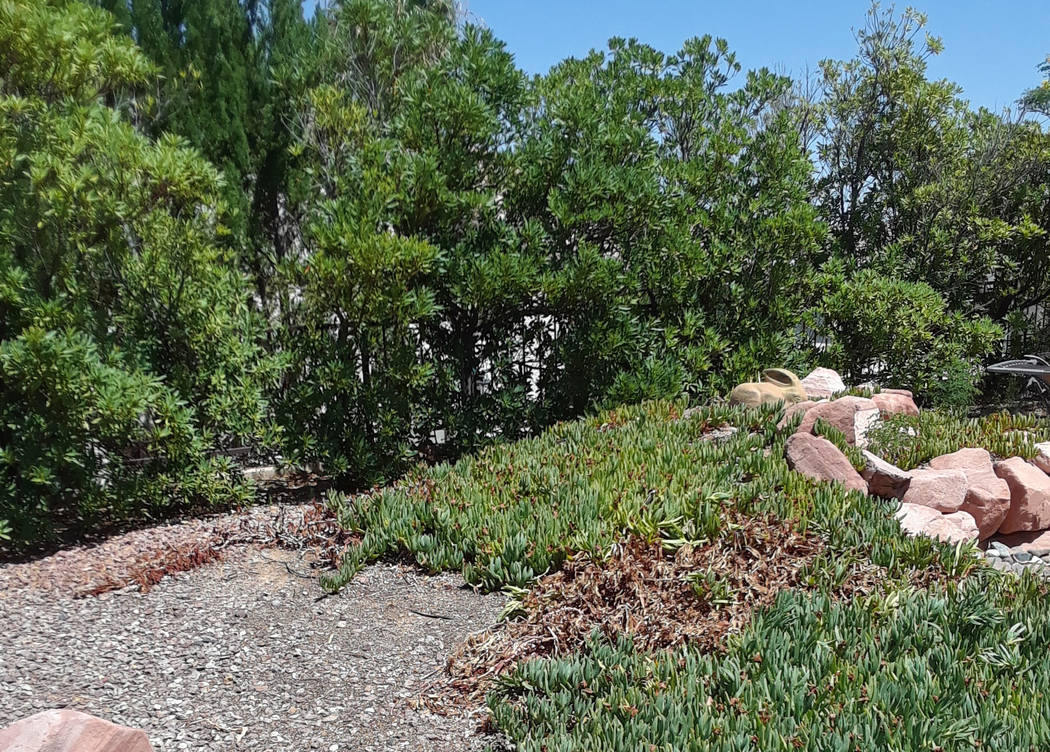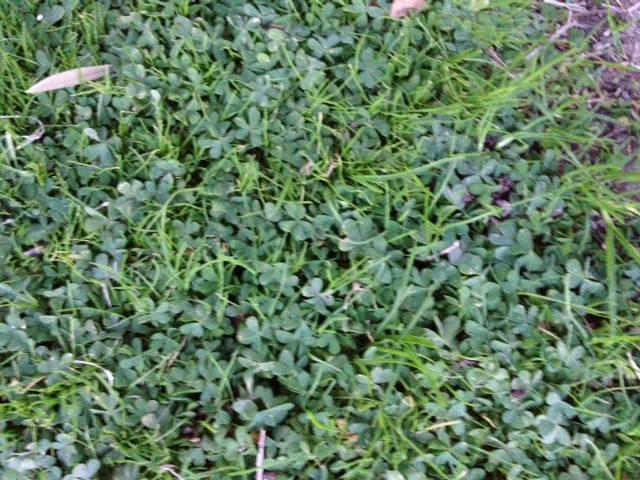Oxalis can be difficult to control in Bermuda grass


Q: We have a very lovely and well-tended hybrid Bermuda lawn. This past fall, and now this summer, it has been invaded by a weed called oxalis. What are your suggestions for killing this weed and not damaging our lawn?
A: Who identified this weed as oxalis? Make sure it is oxalis before trying to control it. Other weeds such as clover look similar, but oxalis has yellow flowers that are distinctive.
Having it in Bermuda grass makes it more difficult to control than in tall fescue. Your choice of weed killers for Bermuda grass is more restricted, but they can be effective.
If this is oxalis, it is perennial and becomes “woody” over time, so apply a weed killer for “woody plants” growing in a Bermuda grass lawn. Two ingredients that work pretty well are fluroxypyr and carfentrazone-ethyl. Look for them under the list of ingredients on the label.
These work best when combined with other weed killers such as 2,4–D, MCPP or dicamba. It will say on the label that it kills oxalis and is safe to apply to Bermuda grass. Look for both conditions.
The best weed control is from liquid weed killers applied with a compressed air sprayer. These can be purchased inexpensively from any nursery or garden center. Accuracy is very important in pest control.
Do not use a hose-end sprayer to apply weed killers or pesticides in general. They are inaccurate for this purpose, when accuracy is needed, but acceptable for applying fertilizers over a broad area.
Apply weed killers early in the morning or late in the day if applied during the summer. Weed control is best done in the fall or spring when day temperatures are cooler, 70s or 80s. Do not irrigate for 24 hours after applications of weed killers.
If applying a dry product, such as a “Weed and Feed,” apply it with a drop spreader, rather than a handheld dry fertilizer spreader. Drop spreaders are more accurate and apply chemicals more evenly, which results in better weed control.
Q: My junipers are starting to die and turn yellow from the top. I water them twice a day: at 7 a.m. and 7 p.m. for 45 minutes. The nursery told me to water them every other day, four days a week, for one hour. What should I do to save them?
A: I saw the pictures you sent. They appear to be sheared as well. Because of dense, internal shading due to their thick canopies, the leaves inside the canopy of these plants die and turn brown. It is only the outer perimeter of leaves that stay green. The inside stems aren’t dead, but the leaves or needles attached to them die and turn brown from a lack of light.
When these plants are sheared, the dead, brown needles in the interior are revealed. Some junipers resprout from these brown, seemingly dead stems, but others may not. However, new growth is slow when they resprout.
Spider mites also can cause needles to brown and drop off. Don’t assume your plant has spider mites unless you confirm their presence.
I use a white piece of paper and slap the brown branches against a white piece of paper several times. This dislodges the spider mites from the needles onto the white piece of paper.
By staring at the white piece of paper for 10 or 15 seconds, you can these tiny spider mites crawling around on it. You must look closely, because they are the size of the period at the end of this sentence.
Washing plants prone to spider mites once a month with a stiff stream of water removes surface dust from the needles or leaves. Removing the dust and dirt also helps control spider mite populations. Soap and water sprays also work if spider mite outbreaks are light.
Junipers are notorious for dying if the soil is kept too wet. Their roots suffocate easily in wet soils. The first sign of overwatering is browning of the tips of the stems. This can be from soils that don’t drain easily or when these soils are irrigated too often.
Be careful of that. Juniper roots like to be on the dry side between irrigations. I think this is what the nursery was hinting at.
It’s hard to judge how many minutes to give them, but each of them should be fine if they receive 5 gallons of water each, distributed under their canopies. This would require at least two drip emitters, but three would be better.
Q: Most of the leaves on my apricot tree withered and turned brown. The same thing, to a lesser degree and later in the season, happened last year. But this spring it brought forth an abundance of blossoms, fresh, green and healthy-looking leaves and produced lots of good fruit. I checked the soil, and it is not dry but slightly moist. I water daily on a drip system for 35 minutes.
A: I looked at the pictures, and three things come to mind when I read your question: daily watering, rock mulch and giving the tree enough water. I don’t know how much water the tree is getting in 35 minutes, but perhaps the tree is running out of water before the next irrigation.
First, the rock mulch. I like rock mulch when it is used around desert plants. I don’t like rock mulch used around nondesert plants such as fruit trees.
You would help the tree by raking back the rock a distance of 3 or 4 feet from the tree and replacing it with 3 to 4 inches of wood chip mulch where there is water applied. Wood chip mulch is free from the University Orchard in North Las Vegas or Cooperative Extension just south of the airport.
Daily watering of trees during the summer is never a good thing and can be tricky to manage. If you give the tree more water during an irrigation and then wait one day before the next irrigation, it would help the tree and perhaps eliminate this leaf drop. Perhaps more water could be added if there were more or higher gph drip emitters under the canopy.
Apply water to at least half the area under the canopy of the tree. This may require more drip emitters than the tree has currently. A tree that size should have at least five to six drip emitters and would do better if there were more than that.
Place emitters about 2 feet apart under the canopy and no closer than 12 to 18 inches from the trunk. A tree that size probably requires 15 to 20 gallons every time it’s watered.
If the tree is watered for 60 minutes and the tree has six drip emitters under its canopy, they must be 3- to 4-gallons-per-hour emitters. If watering for 30 minutes, use 5-gallons-per-hour emitters.
Q: I have an ice plant that has produced flowers in the winter for 12 years. This winter, it took a hit from the cold, so we cleaned out all the yellowing and dead growth, but it’s starting to die out again during the summer. Nothing has changed. We water with small soaker hoses in the ground.
A: Nothing has changed for you, but the plant has gotten bigger. As plants get bigger, their need for water increases, so the number of emitters must be increased or the number of minutes water is delivered. Make sure that the small soaker hoses are still emitting the same amount of water and not plugged.
There are few diseases or insects that attack ice plant. Ice plant browns or dies back if temperatures get too cold during the winter. But it also can die back in the summer from root rot if the soil drains poorly, it isn’t receiving enough water or the soil retains too much water. This is a plant that does not like improved soils very much, but the soil it is growing in must drain freely.
It is hard to say what caused the dieback, but the dead portions need to be removed. Remove the dead parts anytime with pruning shears the same way you pruned them back from winter damage.
Fill empty spaces by propagating your own stem cuttings. Most ice plant cuttings root easily in warm, moist soil. The best time is in the spring, but take your chances and try it when temperatures cool off a bit in late August or September.
Mix potting soil with your existing soil, along with a starter fertilizer, and lay 6- to 8-inch-long stem cuttings so they are slightly buried horizontally in the amended soil. Keep the soil moist by watering it once a day, and they will root quickly.
Bob Morris is a horticulture expert and professor emeritus at the University of Nevada, Las Vegas. Visit his blog at xtremehorticulture.blogspot.com. Send questions to Extremehort@aol.com.













